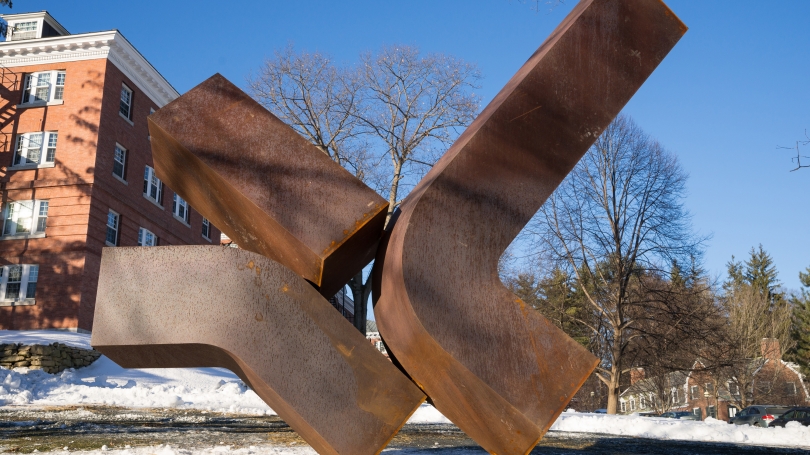Australian- born artist Clement Meadmore (1929–2005) is best known for the large-scale outdoor sculptures that he made after moving to New York in 1963. The Hood Museum of Art at Dartmouth College is delighted to announce the installation of Meadmore's Perdido, a large, complex, abstract composition made from COR-TEN steel. The sculpture was gifted to the museum by Jay R. Schochet, Dartmouth Class of 1952, and his wife, Suzette D. Schochet, and is permanently installed near the corner of Wheelock Street and Observatory Road. It joins a remarkable roster of public art on Dartmouth's campus, including works by such internationally recognized artists as Mark di Suvero, Allan C. Houser, Ellsworth Kelly, Beverly Pepper, George Rickey, Richard Serra, and Joel Shapiro, that have enriched the environment in which Dartmouth and Upper Valley community members live, work, and study.
"As in all of Meadmore's greatest works, Perdido transforms hulking lengths of COR-TEN steel into an abstract artwork of arresting fluidity and inconceivable lightness," said Michael Taylor, Director of the Hood Museum of Art and the Chair of Dartmouth's Public Art Committee. "We are immensely grateful to Jay and Suzette Schochet for their vision and generosity in donating this monumental work to Dartmouth, and to everyone who was involved in the complex installation of the sculpture on campus."
Born in Melbourne, Australia, Meadmore studied aeronautical engineering and industrial design at the Royal Melbourne Institute of Technology and initially pursued a career as a furniture designer. In 1953, he decided to become a sculptor and moved to Sydney to pursue his passion for creating abstract three-dimensional forms out of welded steel. Ten years later he moved to New York, where he was greatly influenced by Minimalism, an artistic movement that attempted to avoid references to anything other than pure form, but he diverged from the minimalist tradition through the dynamic sense of physical movement with which he imbued his sculptures. The artist also insisted that his work differed from minimalism because he created it intuitively, without a preconceived form. Meadmore's sculpture is characterized by its monumental scale and seemingly weightless gracefulness, as seen in Perdido. COR-TEN steel was the artist's preferred medium, due to its natural, weathered appearance and resemblance to unused industrial beams.
Meadmore created a balanced, organic arrangement in Perdido using three enormous steel beams and a concrete base, from which the central form projects powerfully into space, while the other two structures curve gracefully away from one another, thus lending a sense of symmetry and movement to the work. Meadmore was deeply influenced by the improvisation and syncopated rhythms of jazz, which inspired the title for this work, named for a musical composition by Juan Tizol that was recorded by Duke Ellington in 1941.
